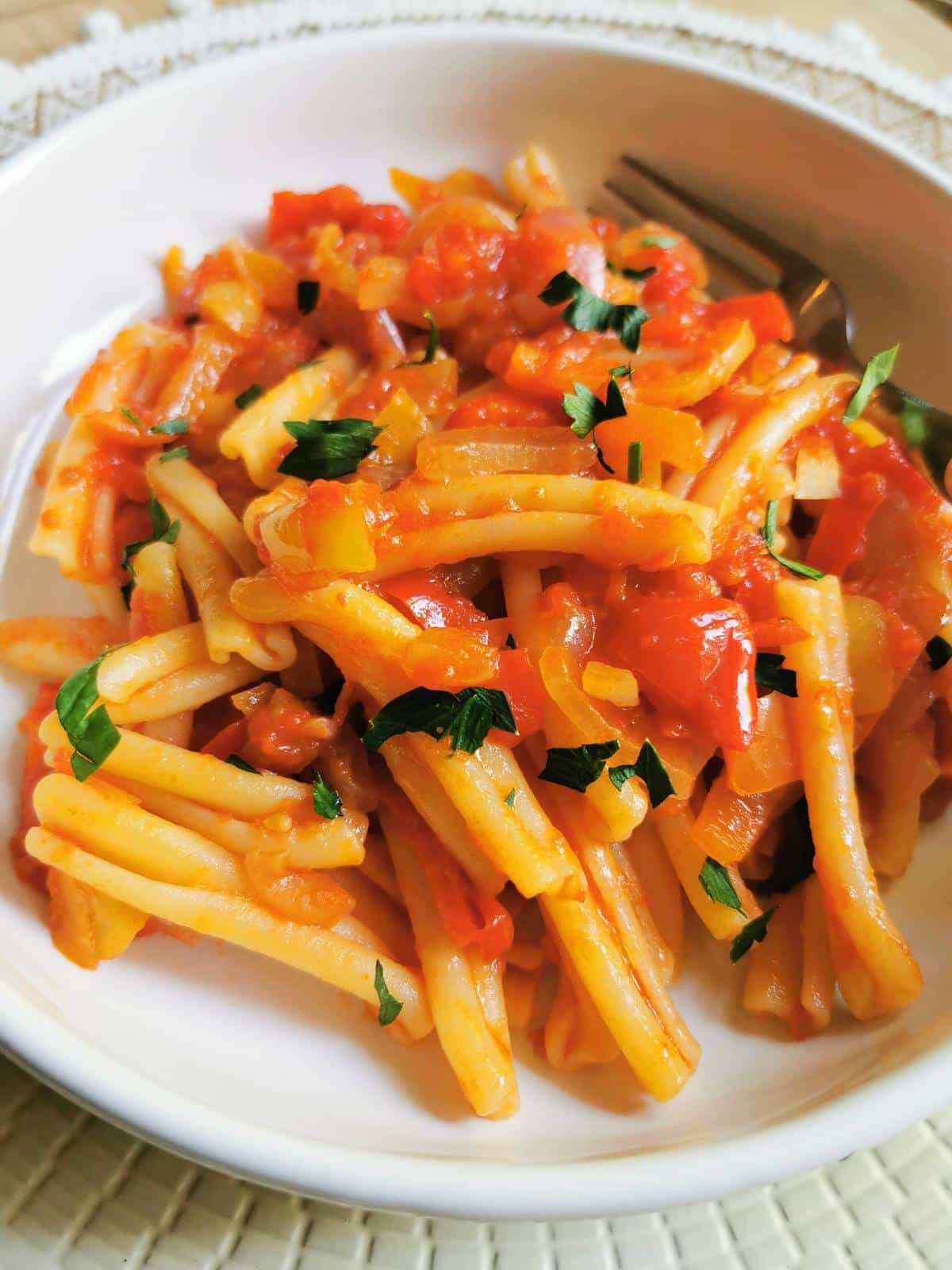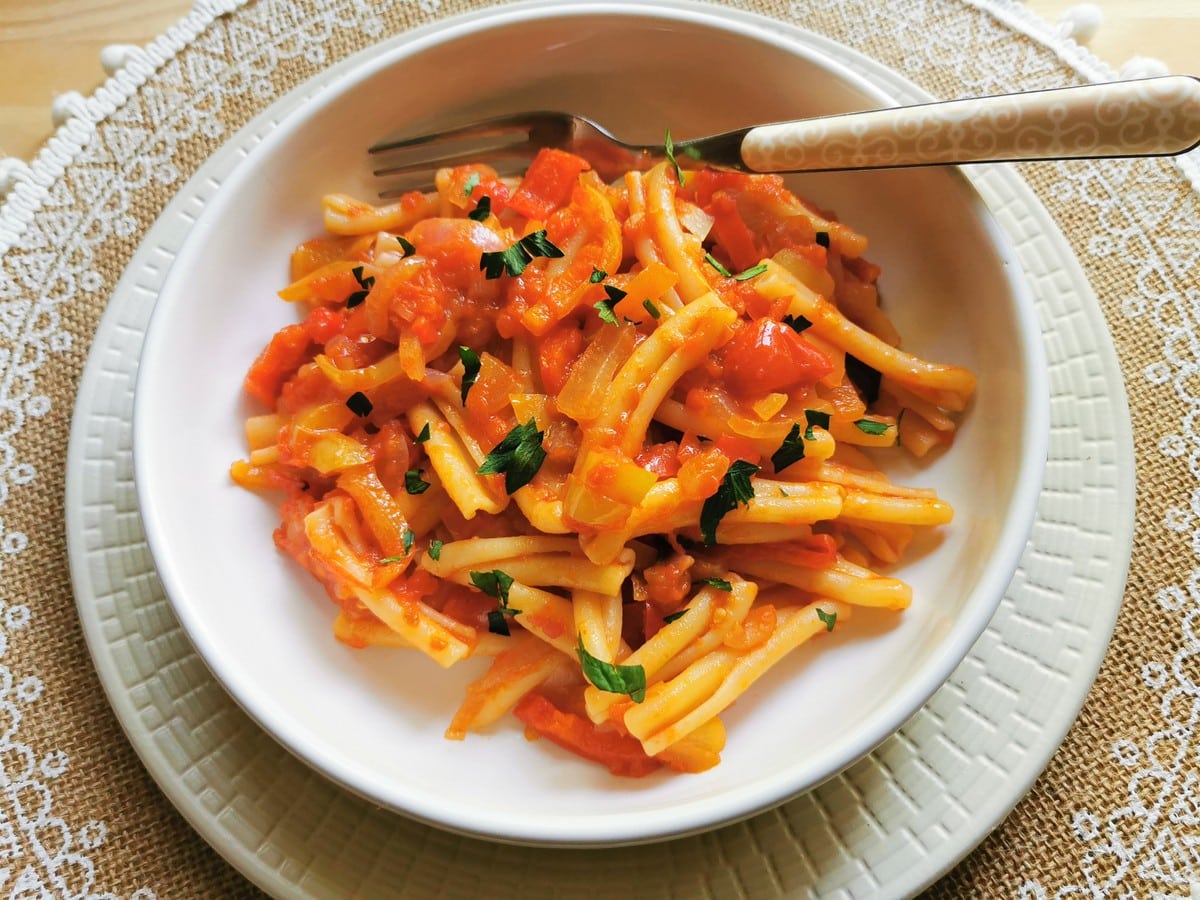The star of this seriously tasty casarecce pasta alla peperonata is a stewed sweet pepper sauce that’s very traditional in Southern Italy. Italians also eat peperonata as a side dish or on bruschetta. Plus, this dish makes a tasty pasta salad!
History
Peperonata is a vegetarian/vegan Mediterranean recipe based on sweet peppers (capsicums) stewed in a pan with garlic, onions and tomato sauce. This is a typical Southern Italian recipe, originally from Sicily, Calabria and Campania. But, it is popular in many other parts of the Italian peninsula.
Peperonata is traditionally a summer dish, since sweet peppers are in season in Italy from June to September. Like many Southern Italian recipes, this is a simple, uncomplicated dish with seasonal ingredients that have bold flavors brought out by the way they are cooked.
Many Italians prefer to eat peperonata cold and, as is often the case with stewed dishes, it tastes even better the next day.

Italians eat peperonata sauce as a side dish with both meat and fish, but also on bruschetta or on pasta, like in this pasta peperonata. I think eating it with pasta is my favorite way to have it! It’s delicious warm or cold as a pasta salad.
This pasta with a sweet pepper sauce recipe is for a classic peperonata with just the basic original ingredients. This is a very simple and reasonably fast sauce. However, simple and fast doesn’t mean bland. This is really tasty!
Every region, or even every town, in Southern Italy has its own recipe for stewed sweet peppers. For example, one version in some areas of Sicily includes breadcrumbs, which are added just before the sauce is ready.
Ingredients

Bell (Capsicum) Peppers: Choose medium-sized, firm peppers, as they tend to be sweeter. You can use a mixture of green, yellow, orange and red peppers or just red peppers if preferred.
Red Onions: If available, use Tropea red onions from Calabria. Their delicate flavor perfectly complements the sweetness of the peppers. If Tropea onions aren’t available, regular sweet red onions or shallots work great, too.
Garlic: This recipe uses whole garlic cloves to infuse the sauce with a mild garlic flavor. The cloves are cooked along with the peppers and onions, providing a subtle depth to the overall taste without being too intense.
Tomato Passata: Use a high-quality tomato passata brand, also known as tomato purée in the US. A good quality tomato passata will provide a more flavorful and slightly sweeter flavor to your peperonata sauce.
Cherry Tomatoes: These are added to enhance the tomato flavor and add a bit of texture and bursts of sweet tomato flavor to the sauce.
Wine Vinegar: A small amount of wine vinegar adds a subtle tanginess to the sauce, balancing the sweetness of the peppers and tomatoes.
Casarecce Pasta: Casarecce is a traditional short pasta from Sicily, with curled edges and a groove that perfectly captures the peperonata sauce. This pasta is widely popular throughout Southern Italy and pairs wonderfully with the sweet pepper sauce.
You can use homemade casareece, dried casareece or another type of short pasta like penne, cavatelli, orecchiette or rigatoni, which also pair well with the sauce.

Expert Tips
Make Extra Peperonata Sauce: Consider making a larger batch of the peperonata sauce because it’s incredibly versatile and also great for meal prep. In Italy, peperonata is enjoyed both warm and cold, serving as a flavorful side dish to accompany meats and fish or as a delicious topping for bruschetta.
If you have leftovers after mixing the sauce with pasta, they can be baked into a pasta casserole or even served as a pasta salad.
Reserve Pasta Water: Before draining your pasta, always reserve a cup of the starchy cooking water. This pasta water can be added to the sauce to help adjust the sauce consistency, and the starch from the pasta water helps the sauce cling to the pasta.
Step by Step Instructions
1) In a large frying pan or skillet, heat the extra virgin olive oil over medium heat. Add the sliced onions, whole garlic cloves, and peppers. Cook, stirring often, until the vegetables start to soften.

2) Stir in the tomato passata, halved cherry tomatoes, bay leaf, and wine vinegar. Season with salt. Reduce the heat to low-medium and simmer covered for 30-40 minutes, stirring occasionally. Remove the bay leaf after cooking.

3) While the sauce is simmering, bring a large pot of water to a boil then add salt. Allow the water to come to the boil again and cook the pasta until al dente, according to package instructions. Before draining, reserve a cup of the pasta cooking water.

4) Add the drained pasta directly to the sauce in the skillet. Mix well to coat the pasta evenly. If the sauce seems too thick, add a little reserved pasta cooking water to adjust the consistency.

5) Serve the pasta hot, garnished with freshly ground black pepper, chopped basil or parsley, and a generous sprinkling of grated cheese, if desired.

Storage and Leftovers
Before storing, allow the pasta peperonata to cool to room temperature. Then store any leftovers in an airtight container in the refrigerator for up to 3 days.
Reheating Options:
- Microwave: Reheat the pasta in the microwave, covered, for 2 minutes. Then, continue heating in 30-60 second intervals, mixing in between each interval until hot.
- Baked Casserole: Transform the leftovers into a baked casserole by adding a layer of grated Parmigiano Reggiano and breadcrumbs on top. Bake until the pasta is hot, the cheese is melted and the breadcrumbs are golden and crispy. To keep this recipe vegan, you can also bake the pasta without cheese.
- Pasta Salad: Alternatively, enjoy the leftovers cold as a pasta salad. The flavors will have melded together nicely, making it a delicious and refreshing option for a quick meal or lunch on the go.
FAQs
Absolutely! The peperonata sauce can be made up to 3 days in advance. Store it in an airtight container in the refrigerator, and simply reheat it when you’re ready to mix it with freshly cooked pasta.
Yes, if casarecce isn’t available, you can substitute it with other short pasta shapes like fusilli, rigatoni, orecchiette, or penne. These shapes will also hold the peperonata sauce well.
Yes, you can use canned crushed tomatoes or whole peeled tomatoes. Keep in mind the texture will be more rustic and chunky. If you use whole peeled tomatoes make sure to break them apart with a back of a wooden spoon after they have been simmered for about 20 minutes.
Foodie Travel Tip!
In Italian, sweet peppers (bell peppers/capsicums) are called peperoni (with one ‘p’!). When on holiday in Italy, many non-Italians make the mistake of ordering pizza con peperoni, expecting pepperoni (spicy sausage). Here, spicy sausage/salami isn’t known as pepperoni. If you want spicy salami or sausage in Italy, ask for salame piccante, salamino piccante or salsiccia Napoletana piccante. (piccante means spicy/hot)
More Recipes You May Like:
If you do try this pasta alla peperonata recipe, I’d love to hear what you think. Please write a comment here on the blog or post a comment on the Pasta Project Facebook page.
Your feedback means a lot to me!
Buon Appetito!
Pin for Later:

If you are interested in buying some traditional pasta making tools check out my shop page (affliate links). Plus while you’re there, why not order a copy of one of my pasta recipe cookbooks? They make great prezzies for pasta lovers!
Reader Interactions
Trackbacks
-
-
[…] Imagen: the-pasta-project […]



[…] Imagen: the-pasta-project […]